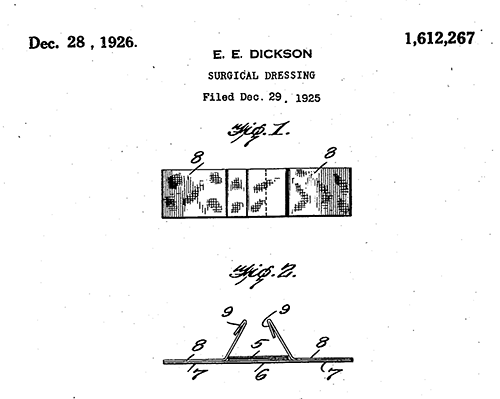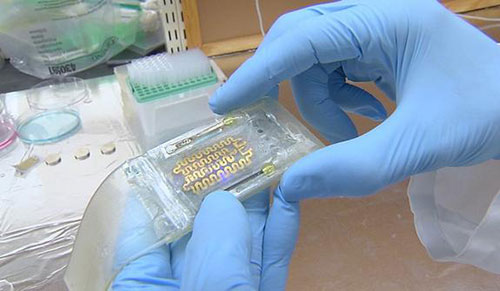This One's For The Wounded
We haven't had Band-Aids forever—only for the last century or so. So what did we use for bandages before then? Well …

A better solution than taking away the knives in the kitchen
Earle Dickson was the perfect person to invent the Band-Aid. He worked for Johnson & Johnson, he knew how to get access to a ton of cotton, and he had someone in his life who really needed them.
And yes, Dickson’s wife Josephine really needed them. Working in the kitchen, she would get cuts constantly from all the knives and kitchen tools she had to work with. While they’d tape up her skin with cotton balls, this proved time consuming and imperfect.
But Earle didn’t give up—he came up with a process to secure strips of cotton and put them on pieces of tape in intervals. It proved a much less annoying way to do things, and when he mentioned it to his bosses, they ran with the idea. And of course, he patented the heck out of it.
It took a while to get things moving, however, because the strips, initially, were made by hand, which made them expensive. Also, they were too large. Worst of all, people didn’t know they needed them yet, and the cost and size issues weren’t helping. Eventually, Johnson & Johnson made a machine to allow for smaller bandages, and made the bandages slightly smaller in size.
That’s all well and good, but there was just one problem: The bandages weren’t selling. Easy enough, the marketers of the world said: we’ll just hand them to the Boy Scouts. The logic in this decision was perfect—it introduced parents everywhere to a logical solution to a problem everyone has.
They’ve probably saved countless pints of blood, and perhaps a number of lives, ever since.
“It is not, however, only the poorer classes of the community who have a weakness for secret remedies and the ministration of quacks; the well-to-do and the highly-placed will often, when not very ill, take a curious pleasure in experimenting with mysterious compounds.”
— The British Medical Association, in a 1909 book titled Secret Remedies: What They Cost and What They Contain, one of the earliest books that took a good hard look at the rise of patent medicine and quackery that became prevalent during the Victorian era. Good thing they did—it helped ensure that modern medicine was a little less hill-of-beany.
Five unusual methods used in treating wounds throughout the ages
- During the era of ancient Egypt, honey was used in wrapping wounds. Later on, sugar was used for similar reasons. While these methods faded with the rise of antibiotics, they have jumped back into favor in recent years, and are still seen as potentially useful today.
- Hippocrates, the noted Greek physician whose name is directly tied to the Hippocratic Oath, was known to treat ulcers with wine and cover them with fig leaves.
- In what sounds like perhaps the worst treatment ever, hot irons were applied to hemorrhoids during the Middle Ages. Hippocrates also recommended the treatment in his manuals. Wine and honey would probably beat this any day of the week.
- Slightly less painful but slightly more weird is the usage of snails to remove warts, a method popular in England. Basically they would take a snail, put it on the wart, and kill it. The stuff that oozed out of the snail would eventually make the wart disappear.
- Even weirder than the snails? Leeches and maggots. Yes, these particularly gross creatures still hold important roles for certain treating certain kinds of wounds. Leeches help restart blood flow after certain kinds of surgery, while maggots can help eat dead skin cells that are blocking a wound from properly healing. Fun.

So where does the future of wound treatment lie, anyway?
What if our bandages had a brain? Rather than simply being devices that we wore on wounds and constantly had the urge to lift out of curiosity about what was underneath, our bandages told us how the wound was doing?
That’s sort of the aspiration that researchers have for flexible bioelectronics, a technology that’s being touted to a degree as the replacement for the band-aid. These bandages would go far beyond what Earle Dickson’s invention was able to offer, giving people with chronic wounds like ulcers an easy way to track the treatment and understand what’s actually happening.
“Current wound care or band-aid technology is designed to protect the wound area from environmental assault,” Harvard associate professor Reza Abdi told the National Science Foundation’s Charlie Heck of the technology. “However, it is a simple technology, which does not provide any information about the state of the wound.”
Another technology, which is being worked on by a number of universities, would be a little bit simpler, but help stop one of the most dangerous parts of the bandage process—the removal portion, which can expose an open sore to disease. The bandage, which would be made out of liquid, would change color if, for whatever reason, the wound isn’t healing correctly.
“Most of the technology was already there,” Massachusetts General Hospital’s Conor Evans told Scientific American last year. “We’re trying to translate it and make it applicable and simple to use in real clinical situations.”
And then, because there’s always a crowdfunding project for everything, there’s an bandage-style wearable that would provide a zap to an area that’s suffering from pain. That project, Cur, would replace physical therapists by detecting pain-causing changes in the body electronically and adjusting. One problem: the FDA hasn’t approved it yet, so, uh, buyer beware.
With all that said, humans are pretty good at healing themselves. Our blood automatically knows how to clot, limiting the spread of unnecessary bleeding and ensuring wounds can start healing on their own.
Now, if you could make bandages that help improve the clotting process, imagine how quickly you could stop a wound from bleeding. This isn’t just me spitballing here—this is something the U.S. military has been focused on for the last couple of decades, which makes sense as they have a vested interest in ensuring that soldiers stop bleeding ASAP.
Fortunately for the military, there’s a modern version of Earle Dickson to save the day. Enter QuikClot, a body dressing that uses the chemical kaolin to help speed up the clotting process. The U.S. military has been using the Z-Medica product since 2008, and it’s probably saved a lot of lives on the front lines.
But despite the obvious benefits of the technology, it wasn’t a big hit with the pharmaceutical companies—and its blood-stopping factor is actually an odd detriment. “QuikClot sounds too good to be true,” CEO Brian Herrman told Hartford Business in 2010.
Where are the Boy Scouts when you need ’em?
:format(jpeg)/2018/04/vka9hwlsxqur0icsw3zl--1-.gif)
/2018/04/vka9hwlsxqur0icsw3zl--1-.gif)

/uploads/ernie_crop.jpg)